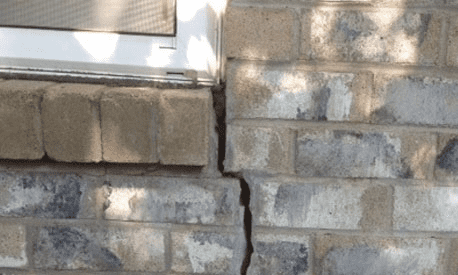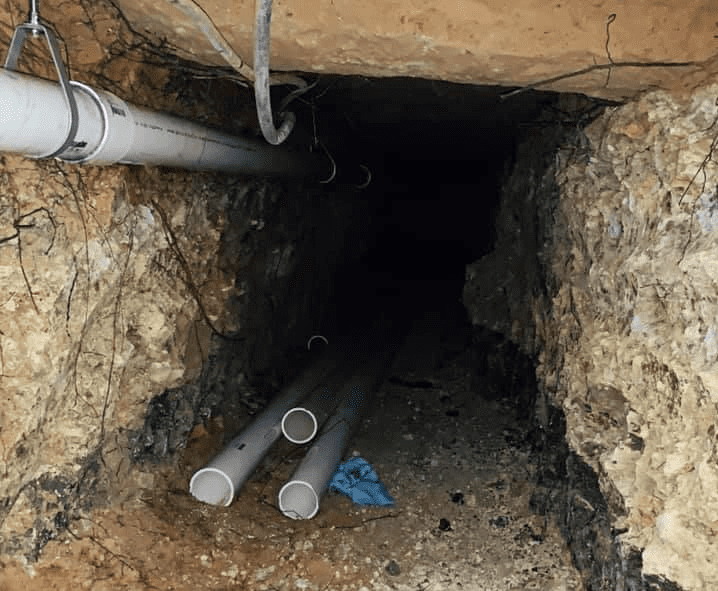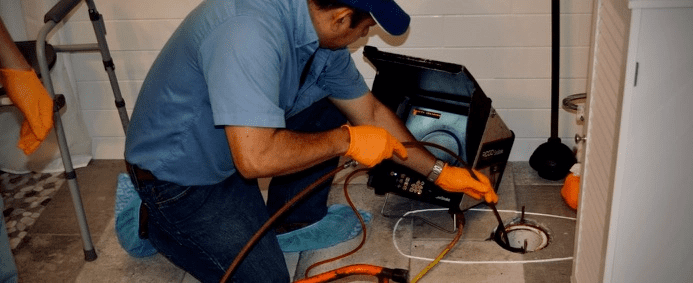
1. Understanding A Slab Leak
Slab leaks, though often elusive, can inflict considerable damage to your home if left unchecked. To effectively tackle this issue, it’s crucial to first comprehend what a slab leak entails.
A slab leak is a stealthy water leak that occurs beneath the concrete slab foundation of your home. These leaks typically result from ruptures in the water or sewer lines running below the foundation. When this happens, water seeps into the surrounding soil, creating a concealed threat that gradually weakens your home’s structural integrity.
This covert menace can remain undetected for extended periods, allowing it to slowly but surely compromise your home’s foundation. As a homeowner, understanding the intricacies of these leaks is vital to protect your property from potential long-term damages. Gaining insight into the causes, signs, detection methods, and repair options for water leaks empowers you to take timely action and safeguard your home from this hidden adversary.
2. Unraveling the Root Causes of A Slab Leak
To effectively address and prevent this, it’s essential to identify their root causes. There are several factors that can contribute to the development of an issue, including:

Corrosion
Pipes made of copper or galvanized steel are susceptible to corrosion over time. Factors such as chemical reactions between the pipes and the soil, and the presence of minerals and impurities in the water, can accelerate this process. As corrosion weakens the pipe walls, it may eventually lead to the formation a leak. Regular maintenance and inspections of your pipes and slab foundation can help identify early signs of corrosion and prevent slab leaks from developing.
Abrasion
As water flows through pipes, it causes them to expand and contract due to temperature changes. This movement can lead to pipes rubbing against the surrounding soil and concrete slab, causing friction and wear on the pipe walls. Over time, this continuous abrasion can weaken the pipes, making them more susceptible to leaks. Proper installation and insulation of pipes can help minimize abrasion and reduce the risk of a plumbing issue.
Poor Construction
Inadequate workmanship during the installation of water lines can pave the way for huge issues. Faulty connections, improperly supported pipes, or insufficient protection against corrosion and abrasion are all potential factors. Ensuring that water lines are installed by qualified professionals and adhering to local building codes can help prevent damage caused by poor construction. Address cracks in your brick house promptly – safeguard its integrity with professional assistance. Act now!
Ground Shift
Changes in the soil beneath your home, such as settling, expanding clay soils, or movement due to earthquakes, can exert stress on the pipes. This stress can cause pipes to crack, bend, or break, leading to slab leaks. Regular inspections, as well as proper installation techniques that accommodate ground movement, can help prevent a plumbing leak caused by shifting soil. Additionally, homeowners in earthquake-prone areas should consider installing flexible pipe connections and seismic shut-off valves to minimize the risk of slab leaks due to ground shifts.
3. Crucial Slab Leak Signs You Shouldn’t Ignore
Your home may be trying to alert you to a slab leak with various warning signs. It’s essential to pay attention to these indicators to address the issue promptly and prevent further damage. Some common warning signs of a slab leak include:
Unusually High Water Bills
A sudden or unexplained increase in your water bills could be a sign of a slab leak. Consistent water loss due to a leak can significantly increase your water usage, leading to higher bills. Keep track of your water consumption and investigate any unexpected changes.
Wet Spots on Floors or Carpets
Moisture or dampness on your floors or carpets, especially in areas without any apparent water sources, can be an indicator of a leaky pipe These wet spots can also lead to the growth of mold and mildew, which pose health risks and damage your flooring materials.
Sounds of Running Water
If you hear the sound of running water when no faucets are turned on or appliances are in use, this could be a sign of damaged plumbing lines. The sound of water moving through your pipes or escaping from a leak may be more audible in quiet moments or during the night.
Cracks in Walls or Flooring
Cracks in your walls, floors, or tiles can be a symptom of a soil expansion, as the water escaping from the leak can cause soil erosion and shifting in the ground beneath your home’s foundation. This movement can, in turn, lead to structural damage and visible cracks in your home.
Mildew or Mold Growth
The presence of mildew or mold growth, especially in areas not typically exposed to moisture, can signal damage. Persistent moisture from the leak can create an ideal environment for mold and mildew to thrive, posing health risks and causing damage to your home.
Sudden Drop in Water Pressure
A noticeable decrease in water pressure throughout your home or in specific areas could be a sign of a slab leak. The water escaping from the leak may reduce the overall pressure in your underground pipes, affecting the performance of your faucets and showers.
By staying vigilant and recognizing these warning signs, you can address slab leaks early on and minimize the damage they can cause. If you suspect you may have an issue, it’s crucial to contact a professional plumber.
4. Effective Techniques for Detecting A Slab Leak

Detecting a slab leak early is crucial to minimizing damage and preventing costly repairs. If you suspect a slab leak, contact a professional plumber who specializes in slab leak detection. Expert technicians use various methods to locate a slab leak, including:
Electronic Leak Detection
Electronic leak detection is a non-invasive method that uses specialized equipment to detect electromagnetic signals emitted by leaking water pipes. This technique is highly accurate and efficient, allowing technicians to locate the source of the leak without the need for extensive excavation or damage to your property.
Infrared Thermography
Infrared thermography is another non-destructive technique that utilizes infrared cameras to detect temperature differences beneath the slab. A slab leak can cause changes in the temperature of the surrounding area due to the presence of water. Technicians use this information to pinpoint the location of the leak, making it easier to plan a targeted repair strategy.
Hydrostatic Pressure Testing
Hydrostatic pressure testing involves isolating the broken pipe by placing an inflatable test ball in the sewer cleanout and filling the system with water. Technicians then monitor the water level in the pipes to identify any leaks. If the water level drops, this indicates a leak somewhere in the system. By comparing the water level drop rate and the location of the sewer cleanout, the technician can deduce the approximate location of the slab leak.
Video Pipe Inspection
Video pipe inspection is another useful technique for slab leak detection. A plumber inserts a small, waterproof camera attached to a flexible cable into your galvanized steel pipes or plastic pipes. This camera allows the technician to visually inspect the interior of your pipes, identify leaks or damage, and assess the overall condition of your pipes.
By employing one or more of these advanced techniques, a professional plumber can accurately detect and locate a slab leak in your home. Once the source of the leak is identified, they can develop a tailored repair plan to address the issue promptly and effectively.
5. The Perils of Overlooking Slab Leaks
Ignoring a slab leak can have serious consequences for your home and your wallet. The potential risks of overlooking a slab leak include:

Structural Damage
Untreated slab leaks can compromise the structural integrity of your home. As water seeps into the soil beneath the slab foundation, it can cause soil erosion and destabilize the foundation. This can lead to cracks in walls, uneven floors, and even foundation collapse, which can result in costly repairs and reduced property value.
Increased Water Bills
A slab leak wastes a significant amount of water, causing your water bills to skyrocket. It can also put strain on your water heater, leading to higher energy bills as the heater works harder to maintain the desired temperature.
Mold and Mildew Growth
As water infiltrates your home through slab leaks, it can create a damp environment conducive to mold and mildew growth. Mold and mildew can not only damage your home but also pose serious health risks, particularly for individuals with allergies, asthma, or compromised immune systems.
Pest Infestations
Damp environments are attractive to various pests such as rodents, insects, and termites. Ignoring a slab leak can inadvertently invite these unwanted visitors into your home, leading to infestations that can cause further damage and create additional health risks.
Plumbing System Damage
Continuous water leakage can lead to increased pressure on your hot water pipes, which may result in additional pipe damage and leaks. Fixing a slab leak as soon as possible can help prevent further damage and more extensive, costly repairs.
Decreased Home Value
The presence of a slab leak and its associated damage can significantly reduce the value of your home. Potential buyers may be hesitant to purchase a property with a history of slab leaks or ongoing problems, making it more challenging to sell your home.
By addressing a slab leak promptly, you can minimize the risks and potential damage to your home. Regular inspections, timely repairs, and proper maintenance can help you avoid the perils associated with overlooking slab leaks.
6. Navigating the Maze of Slab Leak Repair Options

Once a slab leak has been detected, it’s essential to evaluate the available repair options, repair costs and choose the best course of action. A professional plumber will assess the situation and recommend the most suitable method based on the severity and location of the leak, the condition of your slab foundations levels, and other factors. Some of the repair options include:
Spot Repair
Spot repair is a targeted approach that involves removing a section of the slab to access and repair the damaged pipe directly to fix a slab leak. This method is often suitable for isolated leaks and newer systems where the rest of the pipes are in good condition. The repair process requires cutting through the concrete to reach the damaged area, fixing the leak, and then filling and sealing the hole in the slab. Spot repair can be cost-effective for minor leaks but may not address underlying issues in older structures.
Repiping
If your home’s plumbing system is old or severely damaged, repiping may be the best solution. This process involves replacing all or a significant portion of the pipes beneath the slab. Repiping can be an extensive and costly undertaking, but it ensures a long-term solution, especially in cases where corrosion or poor pipe materials are the root cause of the slab leak. During repiping, the plumber may reroute pipes to bypass the slab, reducing the risk of future leaks.
Pipe Relining
Pipe relining is a less invasive option, where a new pipe liner is inserted into the existing pipe to seal any leaks. This method involves using a flexible, epoxy-coated liner that is inserted into the damaged pipe and then expanded to create a tight seal against the pipe walls. Pipe relining can be a cost-effective and less disruptive alternative to repiping in some cases, but it may not be suitable for severely damaged or collapsed pipes.
Foundation Repairs
In some cases, slab leaks can cause significant foundation damage to your home’s foundation. If this occurs, foundation repair may be necessary in addition to addressing the slab leak itself. Foundation repairs can involve various techniques, such as underpinning, installing helical piers, or mudjacking, depending on the extent of the damage and the specific requirements of your home. A foundation repair specialist can assess the situation and recommend the most appropriate course of action.
Ultimately, the best option to fix a slab leak will depend on your unique circumstances. A qualified professional can help you determine the most effective and cost-efficient solution to protect your home and prevent future leaks.
7. Proactive Measures to Prevent Slab Leaks
Prevention is key to avoiding costly repairs and damage to your home. To minimize the risk of a slab leak, consider these proactive measures:

Regular Inspections
Schedule routine plumbing inspections to identify potential issues before they escalate. These check-ups can spot early signs of corrosion, leaks, or other concerns, allowing you to address them before they become serious problems.
Proper Installation
Ensure that water lines are correctly installed during the construction of your home. Hire a qualified and experienced plumber who can lay the groundwork for a solid and leak-free foundation.
Water Pressure Regulation
Maintain an appropriate water pressure level in your home to reduce stress on your pipes. A pressure regulator can help you achieve the optimal level, preventing excessive wear and tear on your concrete foundation.
Water Treatment
Invest in water treatment systems to reduce the risk of corrosion in your pipes. Water softeners can counteract hard water, while filtration systems can remove corrosive elements. By treating your water, you can extend the lifespan of your plumbing system and avoid potential leaks.
Earthquake Preparedness
If you live in an earthquake-prone area, consider installing flexible pipe connections and seismic shut-off valves. These measures can help minimize the risk of slab leaks caused by ground shifts, protecting your home and plumbing system from damage during seismic events.
Landscape Management
Properly managing the landscape around your home can also play a role in slab leak prevention. Avoid planting trees with invasive root systems near your foundation, as their roots can grow into your plumbing system and cause damage. Instead, opt for plants with shallow root systems and maintain a safe distance between your home and any large trees.
Foundation Maintenance
Regularly inspect your home’s foundation for cracks or signs of damage. Promptly repair any issues you find to maintain the structural integrity of your home and prevent slab leaks. This includes maintaining your lawn or foundation plants along the perimeter of the home. Keeping your foundation in good condition can save you time, money, and frustration in the long run.
By following these proactive measures, you can reduce the risk of plumbing damage and protect your home from potential damage. Slab leaks tend to arise when your slab foundation is neglected for significant periods of time. Regular maintenance and vigilance can make a significant difference in preventing costly repairs and preserving the structural integrity of your home.
Conclusion
Slab leaks may be hidden from plain sight, but their consequences can be devastating if left untreated. By understanding the causes, warning signs, and detection methods, you can take proactive steps to prevent and address slab leaks before they spiral out of control. Remember, an ounce of prevention is worth a pound of cure. Don’t let slab leaks undermine the foundation of your cherished home. Stay vigilant, act promptly, and enlist the help of professionals to keep your home safe and dry for years to come.